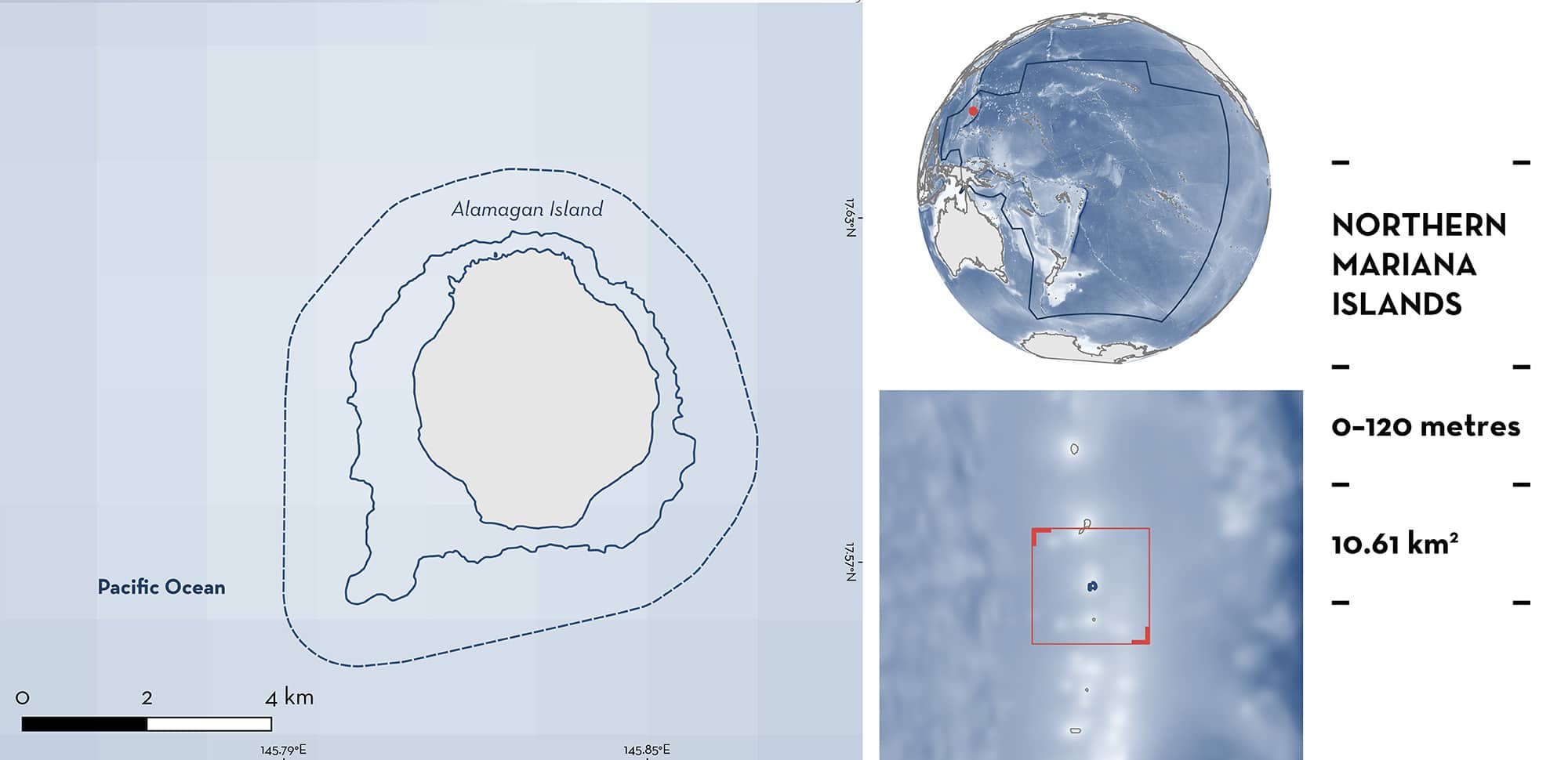ISRA FACTSHEETS
ISRA FACTSHEETS
NEW ZEALAND & PACIFIC ISLANDS REGION
Alamagan Island
Summary
Alamagan Island is located in the middle part of the Mariana Arc northwest of the Pacific Ocean. It is part of the Commonwealth of the Northern Mariana Islands, a self-governing commonwealth in association with the United States of America. The area is characterised by steep reef slopes, boulders with corals, and perpendicular ridges. There are no beaches around this island, and it is surrounded by cliffs. Within this area there are: threatened species and reproductive areas (Grey Reef Shark Carcharhinus amblyrhynchos).
Download factsheet
Alamagan Island
DESCRIPTION OF HABITAT
Alamagan Island is located in the middle part of the Mariana Arc northwest of the Pacific Ocean, 56 km north of Guguan and 111 km south of Pagan Islands. It is part of the Commonwealth of the Northern Mariana Islands, an unincorporated territory associated with the United States of America. North and northeast of this area, steep, narrow ridges incise moderately steep submarine flanks, forming hard, complex substrates with reef slopes, ridges, and boulders. Southeast, a small shelf with complex textures suggests a spur-and-groove habitat (Brainard et al. 2012). To the west, a larger shelf lies at 25–40 m depth, and southwest, a deeper shelf is found at 80–120 m. The southern and southeastern shelves have lower complexity, and more sand cover compared to the northern habitats. Temperatures in the northeast region are lower while salinity and density are higher (Brainard et al. 2012). These differences in temperature and salinity likely result from the upwelling of subsurface waters (Brainard et al. 2012). The coastal waters around the island have one of the lowest salinities of the Northern Mariana Islands where unique assemblages exist (Houk & Starmer 2009).
This Important Shark and Ray Area is benthopelagic and delineated from surface waters (0 m) to a depth of 120 m based on the bathymetry of the area.
CRITERION A
VULNERABILITY
One Qualifying Species considered threatened with extinction according to the IUCN Red List of Threatened Species regularly occurs in the area. This is the Endangered Grey Reef Shark (Simpfendorfer et al. 2020).
CRITERION C
SUB-CRITERION C1 – REPRODUCTIVE AREAS
Alamagan Island is an important reproductive area for one shark species.
Observations have been made from contemporary and historical towed-diver surveys (TDS) and stationary point count (SPC) surveys conducted around the island. TDS method had two divers towed along a 2.2 km track at 15 m depth, recording fish >50 cm TL in a 20,000 km2 area. The SPC method involved two divers counting fish in 15-meter-diameter plots each, covering smaller areas (~350–600 m2). Aggregations comprised exclusively of young-of-the-year (YOY) and juvenile Grey Reef Sharks were recorded in the area. Sharks were determined as YOY and juvenile based on their body sizes compared to the size-at-birth of this species (45–60 cm total length [TL]; Ebert et al. 2021) and the size-at-maturity (120–145 cm TL; Ebert et al. 2021).
Between 2003–2007, 18 TDS were conducted: in 2003 (n = 6 surveys), 2005 (n = 6), and 2007 (n = 6) (CREP PIFSC 2017a). Five aggregations were recorded from TDS surveys, ranging between 3–18 individuals (sizes 63–125 cm TL) (CREP PIFSC 2017a).
Between 2009–2017, 59 TDS were conducted in the area: 2009 (n = 6 surveys), 2011 (n = 3 surveys), 2014 (n = 3 surveys), and 2017 (n = 6 surveys) (CREP PIFSC 2017a, 2017b, 2017c). Four aggregations were recorded during TDS surveys ranging between 2–23 individuals (sizes 70–100 cm TL) (CREP PIFSC 2017a, b). Three aggregations were also recorded in stationary point counter (SPC) surveys in 2011 and 2014 (2–3 individuals, 75–90 cm TL) (CREP PIFSC 2017d, e).
Grey Reef Sharks within aggregations in the area ranged in size from 63–125 cm TL and no shark larger than 150 cm TL was recorded within the area (CREP PIFSC 2017a, 2017b, 2017c, 2017d, 2017e). Considering the depth range of the Grey Reef Shark, the coral reef association, and the estimated 6.2 km2 (1.4–10.8 km2) home range (Bonnin et al. 2021), aggregations of YOY and juveniles in the area support the critical importance of the area the reproductive success of Grey Reef Sharks. However, further information is required to understand the timing of pupping in the area as all surveys were conducted between April–September (CREP PIFSC 2017a, 2017b, 2017c, 2017d, 2017e).
Download factsheet
SUBMIT A REQUEST
ISRA SPATIAL LAYER REQUEST
To make a request to download the ISRA Layer in either a GIS compatible Shapefile (.shp) or Google Earth compatible Keyhole Markup Language Zipped file (.kmz) please complete the following form. We will review your request and send the download details to you. We will endeavor to send you the requested files as soon as we can. However, please note that this is not an automated process, and before requests are responded to, they undergo internal review and authorization. As such, requests normally take 5–10 working days to process.
Should you have questions about the data or process, please do not hesitate to contact us.


